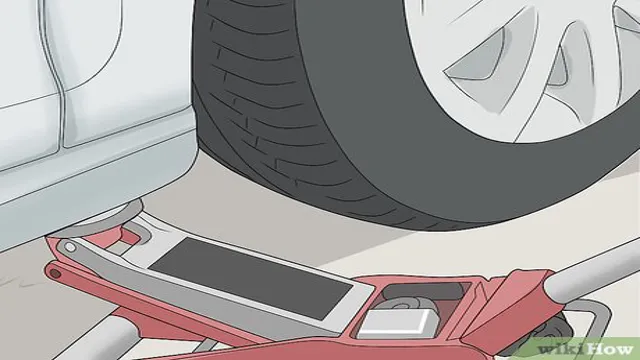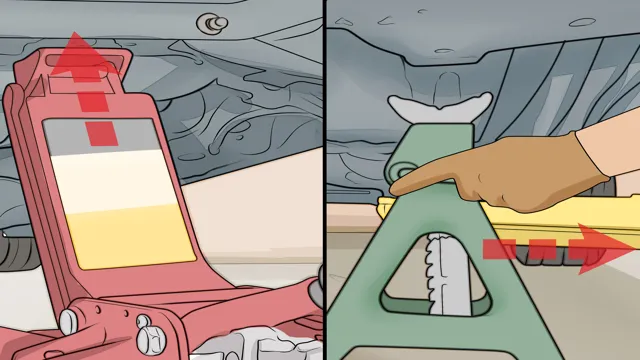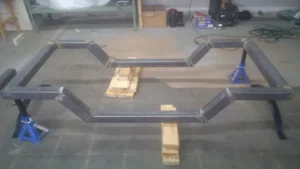Whoever said “safety is no accident” must have been talking about using jack stands properly. If you’ve ever changed your car’s oil or replaced brake pads, you know the importance of a sturdy support system. But are you sure you’re using jack stands safely? It’s crucial to take the right steps to protect yourself, your car, and anyone else nearby.
Otherwise, it could end up being a costly and dangerous mistake. In this guide, we’ll cover everything you need to know about using jack stands effectively and safely. Whether you’re a seasoned mechanic or a beginner DIYer, stay tuned to learn more.
Choosing the Right Jack Stands
If you’re new to car maintenance and wondering how do you use jack stands, you’re in the right place. Jack stands are essential tools for keeping your vehicle elevated during repairs or maintenance and ensuring safety under the vehicle. Choosing the right jack stands for your needs is critical, and there are several factors to consider.
First, think about the weight capacity you need for your vehicle, and ensure the jack stands you purchase can support that weight. Next, consider the height range you need, as some jack stands only extend to a certain height. Finally, look for safety features like locking mechanisms and wide bases to ensure stability.
With the right jack stands in hand, you can confidently tackle any projects on your vehicle while keeping yourself safe.
Check the weight rating
When it comes to choosing the right jack stands for your vehicle, it’s crucial to check the weight rating. The weight rating is the maximum weight that the jack stands can support. Exceeding this weight limit can cause the jack stands to collapse, resulting in serious injury or even death.
To determine the weight rating you need, you’ll need to know the weight of your vehicle and any additional weight that may be loaded onto it. Always select jack stands with a weight rating greater than or equal to the total weight. It’s essential to remember that using the wrong jack stands can lead to catastrophic consequences, so take the time to research and select the appropriate one for your vehicle’s weight.
Don’t take any shortcuts when it comes to safety. Your life and the lives of others on the road depend on it.

Inspect the stands for damage
When choosing the right jack stands, one essential factor to consider is inspecting the stands for damage. It’s crucial to ensure that your stands are in good condition to prevent any accidents or mishaps while lifting your vehicle. When inspecting your stands, look for any cracks, chips, or bends in the metal, and ensure that the welding is secure and free from any corrosion.
If your jack stands have any of these damages, it’s best to replace them immediately. Remember that using damaged jack stands can cause your vehicle to fall, not only damaging important parts, but also putting you and other people at risk of injury. Sparing a few minutes to check your stands for any possible damage can make a significant difference in your safety and the safety of your vehicle.
Always remember to prioritize safety when lifting your vehicle and choosing the right jack stands.
Select the appropriate height
When it comes to lifting a vehicle, choosing the right jack stands is crucial for both safety and ease of use. One of the most important factors to consider is the appropriate height for the job at hand. If the vehicle is too low to the ground, then you’ll need a set of jack stands that can reach a lower height.
Conversely, if the vehicle is too high off the ground, then you’ll need a set of jack stands that can reach a higher height. It’s essential to choose jack stands that can adjust to the appropriate height for your vehicle, as using stands that are too tall or too short can be extremely dangerous. Additionally, it’s important to ensure that your jack stands are rated for the weight of your vehicle, as using stands that can’t support the weight can result in catastrophic failures.
So, be sure to choose carefully, and always prioritize safety when lifting your vehicle.
Prepare Your Vehicle
If you’re planning on working under your vehicle or doing any sort of maintenance that requires you to remove your wheels, then using jack stands is an absolute must. These stands are designed to provide a stable base for your vehicle, allowing you to work safely and without fear of your car falling. But how do you use jack stands? It’s actually quite simple once you understand the process.
First, ensure that your car is parked on level ground and set the emergency brake. Next, create a lifting point by using a jack to raise the car up slightly at the designated jacking points. Once the car is lifted, slide the jack stands under the vehicle and adjust them so that they’re snug against the undercarriage.
Be sure to double-check that the stands are positioned correctly and secure before lowering the car onto them. Once you’ve lowered the car onto the stands, give it a shake to test its stability. Remember, safety should always be your top priority when working with your vehicle, and using jack stands is an important part of staying safe.
Find a level and solid surface
Before starting any maintenance or repair work, it is crucial to ensure that your vehicle is on a level and solid surface. This is to prevent any accidental rolling or slipping that can cause injuries or damage to your car. Finding a level surface can be done by using a spirit level or simply eyeballing the ground.
If the ground is not level, you can use a piece of wood or other material to create a stable foundation. Additionally, making sure that your vehicle is parked on a solid surface is just as important. Avoid parking on soft ground or loose gravel, as it can cause your vehicle to sink or become unstable.
By preparing your vehicle in this way, you are ensuring that you have a safe and secure working environment. This is especially important when it comes to tasks that involve lifting your vehicle. A level and solid surface can greatly reduce the risk of accidents and make any maintenance or repair work much easier.
Locate the jack points
Preparing your vehicle for repairs or maintenance can be a daunting task if you’re not familiar with what needs to be done. One important step is to locate the jack points on your vehicle. These are the designated spots where you lift the vehicle using a jack.
You can usually find them in the owner’s manual or by searching online for your specific make and model. Once you’ve located the jack points, it’s essential to make sure they’re clear of debris and are stable before attempting to lift the vehicle. This will ensure that you don’t damage the undercarriage or cause any injuries.
By taking the time to properly prepare your vehicle, you can avoid problems down the road and keep your car running smoothly.
Slowly lift the car with a floor jack
Preparing your vehicle before lifting it with a floor jack is essential to ensure a safe and successful outcome. First and foremost, make sure your car is on a level surface to prevent it from rolling or tipping. Additionally, you need to check the weight capacity of your floor jack to ensure it can lift your vehicle.
Check the manufacturer’s recommendations or your car owner’s manual for the weight of your vehicle and make sure the jack’s capacity exceeds this weight. It’s also important to position the jack correctly under the jacking point of your car, which is usually indicated by an arrow on the chassis. Finally, engage the emergency brake and put blocks or chocks behind the wheels that are remaining on the ground to prevent the vehicle from moving.
By following these simple preparation steps, you can lift your vehicle with confidence and safety.
Placing the Jack Stands
“How do you use jack stands?” is a common question among car owners and DIY mechanics. Proper use of jack stands is essential to ensure your safety when working under your car. Firstly, you should park your car on a level surface and engage the handbrake.
Then locate the recommended jack points in your car’s owner manual. Place the floor jack under the jack point and raise the car until the wheels are off the ground. Now it’s time to position the jack stands underneath the car’s dedicated jacking points, ensuring they are on a solid surface and the base of the stand is flat.
Lower the car onto the stands and double-check to ensure the stands are securely holding the weight of the car before starting to work. Remember that using jack stands isn’t a substitute for a floor jack, but rather a precautionary measure. Always make sure to follow the instructions carefully and use appropriate stands for the weight of your vehicle.
Position the jack stands under the jack points
When it comes to positioning your jack stands, you want to ensure that they are placed securely under the jack points. This is important because the jack points are designed to hold the weight of the vehicle, and placing the jack stands in the wrong spot can damage your car. To get started, locate the recommended jack points for your specific make and model of vehicle.
These are typically located on the car’s frame or undercarriage. Once you’ve located the jack points, slide your jack stands underneath and adjust them until they are resting securely on the points. It’s always a good idea to give the car a gentle shake before getting underneath to make sure that it’s stable.
By taking the time to properly position your jack stands, you can ensure that your car remains secure and stable while you work on it.
Set the height on the jack stands
When it comes to placing jack stands, it’s crucial to set them at the right height to ensure safety. The first step is to identify the secure and stable jack points on the vehicle’s frame. Then, place the jack stands directly under these points.
It’s essential to choose a level ground when doing this, which means finding a surface without any incline or decline. Once the jack stands are in place, you can adjust their height by using the lever, screw, or pin that comes with them. Make sure to set the height around one notch below the maximum height to ensure stability.
The process might seem time-consuming and tedious, but it’s critical for safety reasons. Failing to do so might cause the vehicle to fall, potentially causing damage or injury. So, take your time, double-check your work, and voila – you’re good to go!
Lowering Your Vehicle
Lowering your vehicle can be a great way to enhance the look and performance of your ride. One essential tool you need when lowering your vehicle is jack stands. To use jack stands properly, first, park your car on a flat surface and engage the parking brake.
Next, use a hydraulic jack to lift the car at the designated jacking points. Then, place the jack stands beneath the car’s sturdy support points and adjust their height to ensure they can securely hold your vehicle. Finally, gently lower the car onto the jack stands and double-check that they’re correctly positioned before releasing the hydraulic jack.
It’s essential to remember that jack stands are not meant for lifting cars, only for holding them in place. Therefore, always use them in conjunction with a hydraulic jack when lifting your car. By following these simple steps, you can safely and efficiently lower your vehicle to achieve the desired look and performance.
Slowly lower the vehicle onto the jack stands
When it comes to working on your car, safety always comes first. That’s why properly lowering your vehicle onto jack stands is crucial. First, make sure your car is parked on a level surface and the emergency brake is engaged.
Then, locate the proper jack points under your car and place the jack there. Slowly begin to raise the car just enough to slide the jack stand under the car at a secure location. Make sure you repeat this process on the other side of the car.
Once both jack stands are in place, slowly lower the vehicle onto them. It’s important to double-check the stands are securely in place before working under the car. Taking your time and being patient with this process can make all the difference in staying safe while working on your car.
Always remember to use quality jack stands and never solely rely on a hydraulic jack to hold your car in place.
Shake the car to test stability
Lowering your vehicle can give it a sleek and attractive appearance, but it also affects its stability. To ensure your car’s stability, it’s important to test it after lowering it. A great way to check stability is to shake the car.
Give it a good push and see if it wobbles or leans to one side. If it does, it’s a clear indication that the suspension is no longer as stable as it once was. You can also take your car for a test drive and see how it handles on different types of roads.
The key is to be safe and thorough when testing your car’s stability. If you find any issues, it’s best to address them immediately to prevent further damage or danger on the road. Lowering your car is a great way to upgrade its look, but make sure it doesn’t compromise its safety and stability on the road.
Final Tips and Precautions
Using jack stands can be a bit tricky, but if done correctly, they can be a lifesaver. Here are some final tips and precautions to keep in mind when using jack stands. First, always use jack stands in conjunction with a floor jack.
Never rely solely on the jack stands to support the weight of the vehicle. Second, always make sure the jack stands are placed on a level surface and are securely locked in place. Third, when selecting jack stands, make sure they are rated for the weight of your vehicle.
Fourth, always inspect the jack stands before use and do not use them if they are damaged or show signs of wear and tear. Fifth, never work under a vehicle that is only supported by jack stands. Always use additional support systems such as wheel chocks or blocks to prevent the vehicle from rolling.
Remember, safety should always be your top priority when working with vehicles, and using jack stands properly is a crucial part of ensuring your safety.
Use wheel chocks for added safety
Using wheel chocks is a simple yet effective way to add an extra layer of safety when parking your vehicle. These small blocks are placed in front of or behind the wheels to prevent the vehicle from rolling, which can be especially important on uneven surfaces or inclines. It’s important to choose chocks that are appropriate for the weight and size of your vehicle, and to ensure they are properly placed before exiting the vehicle.
While many parking areas have chocks available, it’s always a good idea to have your own set in case they aren’t provided. By taking this extra step to secure your vehicle, you’re helping to prevent accidents and keep everyone safe.
Do not work under a vehicle supported only by a jack
One of the most crucial safety precautions to take when working on a vehicle is to never go underneath it when it’s supported only by a jack. This is a common mistake that many people make, often with disastrous consequences. The reason is simple: jacks can fail and collapse, causing the car to fall and crush the person underneath it.
To prevent this from happening, it’s best to use jack stands or ramps to support the vehicle when working on it. These provide a more stable base and reduce the risk of accidents. Additionally, it’s essential to make sure the vehicle is on a level surface and the wheels are chocked to prevent it from rolling.
Always remember to prioritize your safety when working on a car, and never take unnecessary risks.
Lower the car slowly and remove the jack stands
Lowering a car safely requires proper precautions to avoid any accidents. As you slowly lower the car, make sure you keep an eye on the jack stands to ensure they are clear of the vehicle. Once the car is on the ground, remove the jack stands carefully by lifting them out from under the car.
It’s important to never rush the process, as avoiding sudden moves can help prevent injuries or damage to your vehicle. As you’re lowering the car, make sure you’re paying attention to any unusual noises or signs that something may be wrong. Always take it slow and be mindful of your surroundings.
By following these steps, you can safely and easily lower your car and get back on the road in no time.
Conclusion
In conclusion, using jack stands is like having a dependable wingman. They’re always there to support you, never wavering, and ready to lift you up when you need it most. With their steady stability and undeniable strength, you can trust them to keep you safe and steady while you work under your vehicle.
So don’t leave your safety to chance, grab a set of jack stands and let them have your back.”
FAQs
What are jack stands used for and why are they important?
Jack stands are used to raise a vehicle off the ground to perform maintenance or repairs. They are important for safety reasons, as they provide a stable and secure support system for the car.
How do you choose the right size of jack stand for your vehicle?
To choose the right size of jack stand for your vehicle, you need to check the weight capacity of the stand and ensure that it can support the weight of your car. You can usually find this information in the product specifications or on the packaging.
Can you use only one jack stand to support a car?
It is not recommended to use only one jack stand to support a car. Two or more jack stands are needed to provide stability and prevent the vehicle from tipping over.
What is the proper way to position jack stands under a car?
Jack stands should always be positioned under the vehicle’s designated jacking points, which can be found in the owner’s manual. It is important to place the jack stands on a level surface and ensure that they are stable before raising the vehicle.
Can you work under a car supported only by jack stands?
It is not recommended to work under a car supported only by jack stands. It is safer to use additional support systems, such as ramps, to prevent the vehicle from collapsing.
What are some safety precautions to keep in mind when using jack stands?
Some safety precautions to keep in mind when using jack stands include ensuring that the vehicle is on a level surface, using the right size of jack stand, placing the stands under the designated jacking points, and avoiding sudden movements that could knock the vehicle off the stands.
Are there any tips for storing jack stands when not in use?
To store jack stands when not in use, make sure they are cleaned and oiled to prevent rusting. Keep them in a dry, cool place away from moisture and extreme temperatures. Store them in a compact and organized manner to prevent damage.






